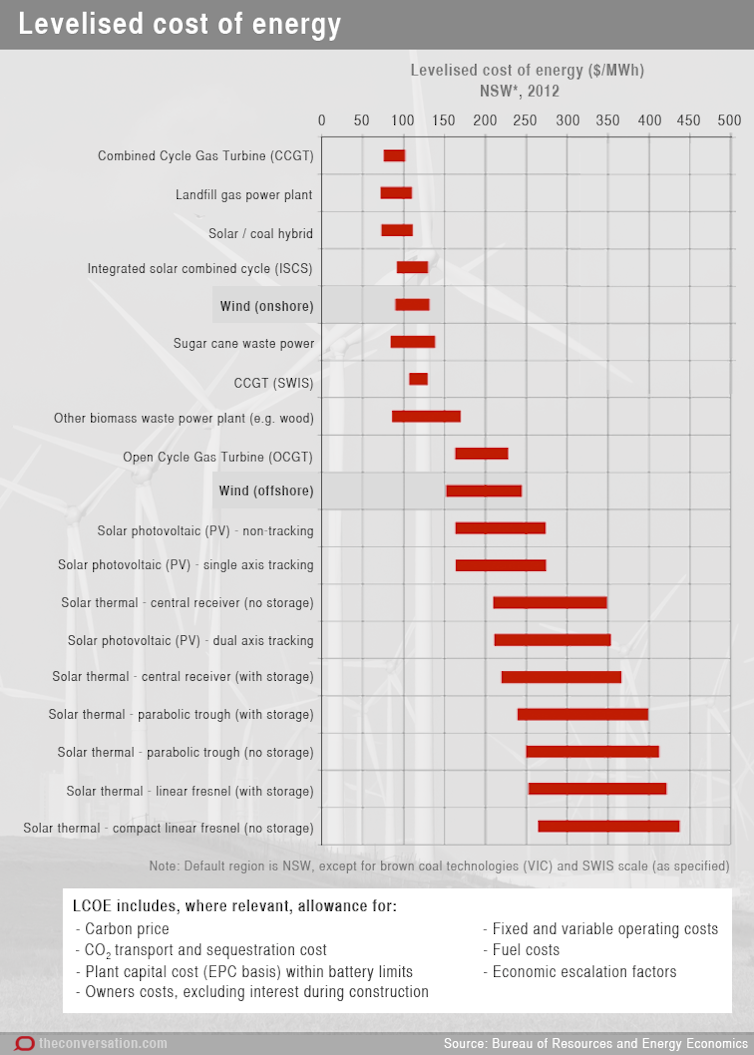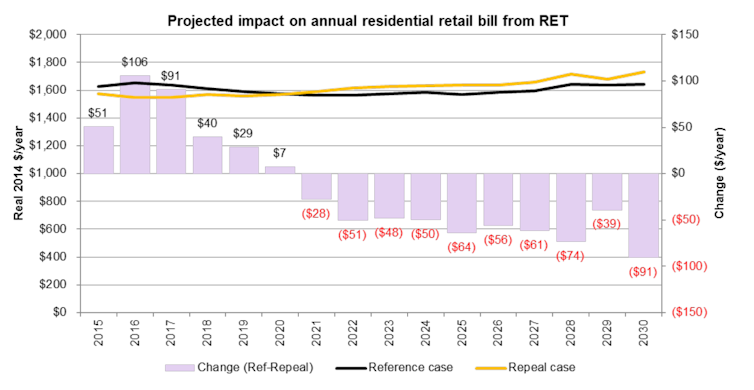80% of Australian energy comes from coal, coal-fired power, and it’s about $79 a kilowatt hour. Wind power is about $1502 a kilowatt hour. That is unaffordable. If you take that power and feed it into the grid, then every person watching this program has electricity bills going through the roof. – Broadcaster Alan Jones, panel discussion on Q&A, ABC TV, July 20, 2015
Alan Jones has told The Conversation by email he acknowledges this comment was made in error and is not correct, saying:
I think you have rightly highlighted a ridiculous mistake that I made… why I said kilowatt-hours and not megawatt-hours and where the 1502 comes from, I have absolutely no idea. What I can tell you is that I’ve used figures for some time now on this issue to merely confirm that renewable energy is many multiples dearer than coal-fired power[…] I previously used that $79 figure but as you can imagine, it’s based on the price of coal. Wind has always been, in my words, three or four times dearer than that.
[…] But if I’ve said that, that is wrong, and I’ll be writing to the ABC to that effect. I have no comment to make other than to thank you for pointing this out to me. I guess we all make mistakes and I’m always happy to correct them when I’m told about them.
Electrical energy is usually measured in kilowatt-hours (kWh) or megawatt-hours (MWh). Kilowatt-hours are the unit generally used for metering and charging residential electricity consumption, and represents the amount of energy a device drawing one kilowatt of power would use in an hour. A megawatt-hour is 1000 times larger, and is typically used to measure large loads or generators. The price quoted (A$79/kWh) is about 300 times more expensive than the typical retail price of electricity paid by residential customers around Australia (and about 2000 times more than current wholesale prices).
Mr Jones’ error in saying kilowatt-hours instead of megawatt-hours is an easy mistake to make.
A$79 per megawatt-hour is consistent with the range of costs reported by the Electric Power Research Institute for new coal-fired electricity in 2010, without carbon capture and storage or a price on emissions.
However, even with the right units, the figure of $1502 for wind power did not make sense. Mr Jones was not able to say from what source he got that figure of $1502 for wind power. So I decided to investigate.
The claim that coal-fired power energy costs $79 a kilowatt-hour and wind power costs $1502 a kilowatt-hour pops up a few times on websites of groups opposing the renewable energy target, climate sceptics, and even in Hansard. Mostly, this claim is referenced to an unnamed Productivity Commission report released in 2010.
The source of the $1502 figure on sceptic sites may be a now-corrected Paul Sheehan opinion piece published by Fairfax in 2011. The correction there reads:
Correction: An earlier version of this piece misquoted energy figures. The Productivity Commission said the cost of electricity generated by wind was $150 to $214 per megawatt-hour, not $1502; and solar was $400 to $473 per MWh, not $4004.
So what did the Productivity Commission actually say?
The 2011 Productivity Commission report that the Fairfax correction appears to refer to was titled “Carbon Emission Policies in Key Economies”.
Box 4.1 of that report, titled “The costs of electricity sources” is about the “levelised cost of electricity” (LCOE), a widely-used measure of the cost of electricity generation technologies energy that includes all lifetime costs and factors in the lower utilisation rates of wind power. Box 4.1 says:
The Electric Power Research Institute (2010) reported estimates of the LCOE of various sources of electricity in Australia, including:
coal-fired electricity (without carbon capture and storage) — A$78–91/MWh
combined-cycle gas turbines (without carbon capture and storage) — A$97/MWh
wind — A$150–214/MWh
medium-sized (five megawatt) solar PV systems — A$400–473/MWh.
Without being certain, my best guess is that some of the groups or websites using the figures of $79 per kilowatt-hour for coal-powered energy and $1502 per kilowatt-hour for wind powered energy may have based their figures on the now-corrected Paul Sheehan opinion piece.
There is no credible economic analysis that reports wind power costs at A$1502 a megawatt-hour.
As he has readily acknowledged, Alan Jones’ figures on the cost of wind energy are not correct.
Are those Productivity Commission figures up to date?
The Commission’s report said that in 2010, the Electric Power Research Institute estimated that the levelised cost of coal-fired electricity (without carbon capture and storage) was between A$78 and $91/MWh. For wind, the figure was between A$150 and $214/MWh. At the time the Commision’s report was released (May 2011), these figures were already higher than other reported costs for renewable energy technology.
More recent costs for new coal plants have been estimated by the former Bureau of Resources and Energy Economics in their Australian Energy Technology Assessment.
This report provides a measure of the cost of a large range of generation technologies, now (or rather, in 2012 when the most recent report was published) and into the future. Using data from Table 5.2.1 of that report, the table below shows the “levelised” cost of energy for some coal and wind technologies.

The chart above, from the Australian Energy Technology Assessment 2013 Model Update (Figure 8) also shows more current levelised costs of energy.
Does 80% of Australia’s energy comes from coal-fired power?
Nearly, but not quite. More than two-thirds of electricity is produced from coal, 19% from gas, and 10% from renewables with the balance from liquid fuels such as diesel, according to the government’s Australian Energy Resource Assessment.
In the National Electricity Market, supplying the eastern seaboard, brown and black coal supplied 76% of output last financial year, and 74% the year before that.
Does feeding renewable energy into the grid drive electricity prices through the roof?
Modelling done by ACIL Allen Consulting as part of the government’s report of the expert panel on the Renewable Energy Target shows that renewable energy generation can represent a net saving to consumers:
The ACIL Allen modelling estimates that repealing the RET would initially result in lower retail electricity prices, however from around 2021 retail prices would be on average 3.1% higher for residential, commercial and industrial customers.

Verdict
As he has readily acknowledged, Alan Jones’ statement on Q&A on the cost of wind and coal powered energy is not correct.
His claim that renewable energy is having a large impact on residential electricity bills also runs counter to modelling commissioned by the government.
Review
This is a thorough FactCheck article. Mr Jones’ cost estimate for coal (assuming it is per megawatt-hour, not per kilowatt-hour) is confirmed by the fact checker. This applies to new coal plant, not existing units.
With regard to the percentage of Australian electricity generated from coal, the FactCheck author is correct. Some people quote higher coal percentages. First, it used to be higher. Second, some people confuse the percentages of input fuel used to generate electricity (historically easier to identify from public data) with the share of electricity actually generated. Since coal plant is less efficient than some other options such as hydroelectricity, this approach makes its share look bigger.
In terms of impacts on future electricity prices, all estimates are based on assumptions. For example, if more old coal generation capacity is retired than some models have assumed, baseline electricity prices could be higher because new generation options of all kinds are typically more expensive than old existing power stations.
Further, the costs of renewable electricity generation are falling, as discussed above. For example, a 2014 Bureau of Resources and Energy Economics study shows 2013 estimates for wind energy cost of A$63 to A$107 per levelised Megawatt-hour of electricity – 6.3 to 10.7 cents per kilowatt-hour, lower than earlier estimates (Figure 19, p.67). – Alan Pears

